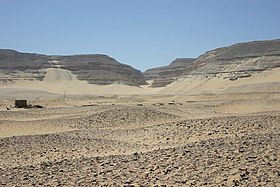Umm el-Qaab
| Peqer ( Middle Kingdom ) in hieroglyphics | |||||
|---|---|---|---|---|---|
Peqer Pqr |
|||||
| The necropolis covered with ceramic shards | |||||
Umm el-Qaab (also Umm el-Gaab , Arabic أم الجعاب, DMG Umm al-Qaʿāb , literally: mother of the pots , also mother of the sacrificial vessels ; ancient Egyptian Peqer ) is the modern name of the ancient Egyptian royal necropolis , 2 km southwest of Abydos , in which over 650 tombs were found.
The contemporary name could not be determined until today. The graves located there belong to the late kings of Dynasty 0 as well as the kings ( pharaohs ) of the 1st and 2nd dynasties (about 3000 to 2700 BC). Umm el-Qaab is one of the places known as the grave of Osiris , alongside Dedu , Philae and Mendes , among others . The necropolises U and B discovered here are the most important. Despite their separate names, however, it is a burial site.
history

Umm el-Qaab has developed from a simple cemetery area in the early predynastic Naqada period to a burial place for a higher class of the population in the Naqada II period. The high point of the Naqada III period was the burial of King Scorpio I (grave Uj). This was the beginning of the early dynastic royal burials which ended at the beginning of the 3rd dynasty .
In the Old Kingdom stood cemetery under the protection of abydenischen Nekropolengottheit Chontamenti that but on the 5th Dynasty arisen Osiris lost -Verehrung important. Osiris later used Chontamenti as a nickname. In some private steles from the Middle Kingdom, acts are described that were committed in honor of Osiris. The necropolis could be visited directly by pilgrims in the late period .
exploration
The royal cemetery was discovered by Émile Amélineau in 1885 and excavated until 1899. Flinders Petrie dug there from 1899 to 1901 and systematically explored the graves.
Archaeologists Édouard Naville and Eric Peet also dug here from 1912 to 1919. Since 1977 further excavations have been carried out by the Cairo department of the German Archaeological Institute under the direction of Werner Kaiser and later Günter Dreyer .
Gravesites
The royal necropolis originally consisted of two separate parts. Umm el-Qaab as a cemetery and the valley districts of the tombs on the edge of the desert, of which Schunet al-Zebib (Arabic: raisin barn ) is the most important and is located about two kilometers north of Umm el-Qaab.
As the latest excavations have shown, the cemetery was laid out as early as the Naqada period (around 3500 to 3000 BC). He is called cemetery U . There were numerous small, but also larger graves from this time. Some graves can be attributed to pre-dynastic kings due to their size (see: Scorpio I. ). Especially in the 1st Dynasty, the place was the burial place of the Egyptian kings. In the 2nd dynasty, however, only two rulers were buried here.
Most of the graves had a stele on which the name of the ruler or official (in the case of secondary burials) was. Most of the grave sites are only preserved in the underground pits. The superstructures that were once in place have completely disappeared. In each of the graves laid since King Hor Aha, a large number of side graves have been found in which servants and perhaps officials of the Pharaoh found their final resting place. This custom of secondary burials is no longer documented in the 2nd dynasty.
In the last century a basalt sculpture was discovered in the grave of Djer , which became known as the "Osiris bed". The sculpture was first dated to the 25th / 26th, later to the 13th dynasty , around a thousand years after the death of King Djer. It can be seen today in Cairo in the Egyptian Museum . Since then, research has seen the grave of Djer as the starting point for the actual Osiris cult. That is why the tomb is also called one of the "Osiris tombs". According to the latest excavation results, the whole royal necropolis was connected to the god Osiris. There have been renovation work on various grave structures since the Middle Kingdom. Especially in the New Kingdom, the necropolis became a kind of pilgrimage center. Small vessels were sacrificed that gave the place its current name. It is estimated that eight million pots were laid here. The local tomb of Osiris is referred to in ancient Egyptian sources as the Mahat . According to myth, Isis found her husband's head in Abydos .
The tombs also included large, fortified valley districts near Abydos, where funeral ceremonies and the cult of the dead for every ruler took place.
Found objects
- Dagger handle K 1104
- Knife handle K 1262a
- Knife handle K 1262b
- Knife handle K 1103
- Knife handle K 2185
- Knife handle K 2186
- Knife K 3325 + K 3324
- Dagger handle K 3475
List of the largest tombs
| dig | Ruler | size | Secondary graves | description | image |
|---|---|---|---|---|---|
| Uj | Scorpio I. | approx. 8 × 10 m. | The tomb of King Scorpio I has 12 chambers. The burial chamber is approx. 2.9 × 4.7 m in size, to the east of the burial chamber there are nine storage rooms, which are divided into three rows of three chambers each. Presumably due to the increased space requirement, two somewhat larger storage rooms were added in a later construction phase. The grave is, for this time and in this size, an unprecedented find. All previous royal tombs consisted of one or two chambers. A scepter found in the burial chamber proves the royal position of Scorpion I. In the storage rooms there were jugs for approx. 4000 liters of wine. The wine jugs were labeled: " Plantation of the (King) Scorpion ", and around 160 tiles made of ivory and stone with letters and words on them were found, which enabled perfect identification. These are the oldest written finds in Egypt. | ||
| B 1/2 | Iri Hor also Irj Hor | B 1: approx. 2.5 x 7 m, B 2: approx. 4.5 x 2.5 m |
This grave was discovered by WM Flinders Petrie . This is a type of grave that is new for this time and consists of two separate chambers: the larger chamber (B 1) as a burial chamber and the smaller chamber (B 2) as a magazine room. |

|
|
| B 7/9 | Ka | B 7: approx. 6 × 3.3 m, B 9: approx. 6 × 3 m |
King Ka was the immediate successor of King Iri Hor. His tomb has the same construction and spatial arrangement as the tomb of his predecessor, only there are differences in the size of the chambers. About 40 objects were found in the grave with the name Ka written on them, which made it possible to identify them. |
|
|
| B 16/17 | Narmer | both approx. 10 × 3 m | King Narmer's tomb also consists of two chambers. Here the chambers are not built separately, but are directly next to each other only separated by a wall. A stele was found for the first time at this grave. |

|
|
| B 10/13/14/15/16/19, |
Aha | 36 | The tomb of Hor Aha is a royal tomb with five chambers and a side tomb complex. The three main chambers B 10, 15, 19 are approximately the same size and the same distance from one another. The chambers B 13, 14 are slightly smaller. The king was probably buried in the middle of the three large chambers (B 15). B 16 contains the side grave complex with 32 grave chambers. In the easternmost chamber there was a “lion's grave” with two adult and five young animals. |

|
|
| B 40/50 | Teti I. Atoti | B 40: approx. 10 × 8 m B 50: approx. 6 × 7.5 m |
The tomb of King Teti I was again built in two separate chambers. B 40 the royal burial chamber and B 50 a system with four chambers of approximately the same size. An assignment is not possible with certainty because no inscriptions were found. The unfinished grave suggests an emergency burial, which points to King Teti I. He only ruled for about 10 months and then passed away very suddenly. | ||
| O | Djer | approx. 18.4 × 17 m | 318 | The tomb of King Djers covers an area of 40 × 70 m. The complex consists of a large main chamber, which is surrounded by many small chambers for the 318 secondary burials . This form of the grave complex is used in all graves of the 1st dynasty. |

|
| Z | Wadji (Djet) | approx. 13.5 x 11.4 m | 178 | The tomb of King Djet is similar to that of King Djer. The main chambers are roughly the same size, only the number of secondary burials has decreased to 178. There are 19 magazine chambers / niches in the main chamber. |

|
| Y | Meritneith | approx. 16.5 × 14 m | 41 | The tomb of Queen Meritneiths consists of a burial chamber approx. 9 × 6.3 m and 41 secondary graves that are located around the burial chamber. The burial chamber is surrounded on all four sides by two storage rooms. Queen Meritneith is the mother of Hor Den. Since he was still a child when his father died, she ran the kingdom for several years. |

|
| T | Den (Dewen, Udimu) | approx. 23.5 × 14 m | 121 | The central burial chamber has a floor area of approx. 15 × 8.5 m. It is surrounded in the north, east and west by small chambers for the 121 side burials. For the first time, an approximately 23.5 m long staircase leads into the grave from the northwest. After the burial, the burial chamber was locked and the corridor surrounding the stairs was filled in. |

|
| X | Anedjib (adjib) | approx. 6.8 x 4.5 m | 63 | The tomb is designed similar to that of Hor Den and also has stairs, but is smaller. Around the main chamber there are 63 smaller chambers for the secondary burials. |

|
| U | Semerchet | approx. 16.5 x 7.5 m | 68 | The burial chamber is surrounded on all sides with smaller chambers for the 68 secondary burials. For the first time, the graves for the secondary burials are located directly on the wall of the main burial chamber. A 10 m long ramp led down into this grave. |

|
| Q | Qaa | approx. 10 × 5 m | 26th | King Qaa is the last ruler to continue the tradition of secondary burials. In front of the burial chamber are six smaller storage rooms, through the middle of which the entrance stairs lead. Again separated only by a wall, the chambers for the 26 secondary burials are arranged around the king's burial chamber. |

|
| P | Peribs | approx. 21 × 18.5 m | no | 9 storage rooms are arranged around the king's burial chamber, connected by long corridors. The entire facility is rectangular. The custom of secondary burials ended at the beginning of the 2nd Dynasty. Access was via a ramp. There was at least one royal stele at the entrance to the grave. | |
| V | Chasechemui | approx. 69 × 10/17 m | no | King Chasechemui was the last pharaoh to build a tomb in Umm el-Qaab. 54 magazine rooms were arranged around the burial chamber, the burial chamber is approximately 5.3 × 3.3 m in size. The entire system forms an elongated rectangle. Bronze vessels were found here for the first time. |
literature
- Émile Amèlineau: Les Nouvelles Fouilles d'Abydos. 3 volumes (in 4). Leroux, Paris 1895-1904.
- AJ Arkell: The Prehistory for the Nile Valley. Brill, Leiden u. a. 1975, ISBN 90-04-04397-7 , (= Handbuch der Orientalistik 7th section, 1st volume, 2nd section, serial 1), content (PDF; 22 KB) .
- Günter Dreyer u. a .: Umm el-Qaab. Follow-up examinations in the early royal cemetery 7./8. Preliminary report. In: Communications from the German Archaeological Institute (DAI), Cairo Department. 52, 1996, ISSN 0342-1279 , pp. 11-81.
- Günter Dreyer: Umm El-Quaab I. The predynastic royal tomb Uj and his early written documents (= Archaeological Publications. Vol. 86, German Archaeological Institute, Cairo Department [DAI]). von Zabern, Mainz 1998, ISBN 3-8053-2486-3 .
- Günter Dreyer: Abydos, Umm el-Qa'ab. In: Kathryn A. Bard (Ed.): Encyclopedia of the Archeology of Ancient Egypt. Routledge, London 1999, ISBN 0-415-18589-0 , pp. 109-114.
- Gabriele Höber-Kamel: Abydos - Religious center of the resurrection . In: Kemet. 2, 2000, ISSN 0943-5972 , pp. 4-9.
- Michael A. Hoffman: Egypt Before the Pharaohs. The Prehistoric Foundations of Egypt Civilization. Dorset Press, New York 1979, ISBN 0-394-41049-1 .
- Michael Müller: Umm el-Qaab . In: Kemet. 2, 2000, ISSN 0943-5972 , pp. 15-19.
- Édouard Naville : The Cemeteries of Abydos. 1: 1909-1910. The mixed cemetery and Umm El-ga'ab (= Memoir of the Egypt Exploration Fund. No. 33, ISSN 0307-5109 ). Egypt Exploration Fund u. a., London 1914.
- William Matthew Flinders Petrie , Francis Llewellyn Griffith : The royal tombs of the First Dynasty. 1900: Part 1. (= Memoir of the Egypt Exploration Fund. Vol. 18, ISSN 0307-5109 ). Offices of The Egypt Exploration Fund, London 1900, digitized .
- Hermann A. Schlögl: Ancient Egypt. History and culture from the early days to Cleopatra. Beck, Munich 2006, ISBN 978-3-406-54988-5 .
Web links
Notes and individual references
- ^ Rainer Hannig: Large Concise Dictionary Egyptian-German: (2800-950 BC) . von Zabern, Mainz 1995, p. 1145.
- ↑ See Michael Müller: Umm el-Qaab In: Kemet, Heft 2, Berlin 2000, pp. 15-19.
- ↑ Dreyer: Umm El-Quaab I-The predynastic royal tomb Uj
- ↑ Gabriele Höber-Kamel: Abydos - Religious Center of Resurrection In: Kemet, Heft 2, Berlin 2000, pp. 4–9.
- ↑ Cairo, JdE 32090; A. Leahy: The Osiris 'Bed' Reconsidered , In: Orientalia 46 (1977), pp. 424-434.
- Jump up ↑ Flinders Petrie, Francis L. Griffith: The royal tombs of the First Dynasty. 1900: Part 1. London 1900, p. 7.
- ^ Heinrich Schäfer: The Mysteries of Osiris in Abydos under King Sesostris III. after the memorial stone of the master treasurer I-cher-nofret in the Berlin Museum (= studies on the history and antiquity of Egypt. [UGAÄ] vol. IV, part 2). Hinrichs, Leipzig 1904, pp. 28-29.
- ^ Hermann Alexander Schlögl: The ancient Egypt . Beck, Munich 2008, ISBN 3-406-48005-5 , p. 59
- ↑ Werner Kaiser, Günter Dreyer: Umm el-Qaab - follow-up examinations in the early royal cemetery. 2. Preliminary report. In: Communications from the German Archaeological Institute, Cairo Department. (MDAIK) No. 38, von Zabern, Mainz 1982, p. 219.
- ^ A b German Archaeological Institute (DAI) Cairo Department, circular September 2002, pp. 13–15.
- ↑ DAI Dept. Cairo, September 2004 circular, pp. 12-14.
- ^ DAI Dept. Cairo, circular December 2003, pp. 12-13.
Coordinates: 26 ° 10 ′ 29.7 ″ N , 31 ° 54 ′ 28.3 ″ E

